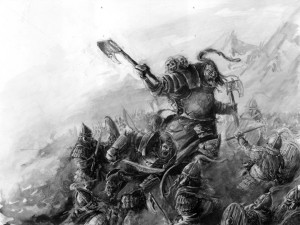
In particular, he examines whether persistent criticism of this key villain might be a result of flaws inadvertently introduced by the relatively late switch from two films to three.
Did Azog defile An Unexpected Journey?
By Rud the Spud
Azog is an aspect of The Hobbit: An Unexpected Journey that has perturbed me for some time now.
Did he or didn’t he work in An Unexpected Journey? And, if not, was he the victim of the late change from two to three films?
I don’t know if it was the massive hype (which I’m glad there is less of for Desolation of Smaug), the huge expectations off the back of The Lord of the Rings movie trilogy or whether it was simply the basic love for the book itself, but I found An Unexpected Journey mildly disappointing.
Don’t get me wrong, I enjoyed it and I loved so many aspects of it but there remains an uneasy feeling that I’ve only recently been able to define.
And that is Azog.
AZOG IN THE TOLKIEN’S LEGENDARIUM

In Tolkien’s Legendarium, the Battle of Azanulbizar was fought in retaliation for this dishonour.
In An Unexpected Journey, the battle is condensed into Thrór’s large-scale attempt to retake Moria. It is during this battle that Azog decapitates him in the film. Events are altered: in the book it was Náin, father of Dáin Ironfoot, who Azog slew. And it was Dáin (who will be played by Billy Connolly in There and Back Again) who leapt after Azog and hewed off his head before Moria’s East Gate.
At Azanulbizar, Thorin did fight off several orcs with an oak branch, but Tolkien does not report that he went near Azog. But the upshot is that Azog was truly slain in the battle. He does not return; it is his son, Bolg, who nurses the grudge against Dáin and the dwarves. And it is Bolg who leads the wargs and goblins into the Battle of the Five Armies. Bolg’s role in the movies is yet to unfold.
The alteration of events for the sake of making a concise screenplay is understandable and acceptable. The filmmakers instead use the Azanulbizar to emphasise the heroism of our central character Thorin and establish back stories for Balin and Dwalin. Even the survival of Azog wasn’t a major issue for me initially. It was a little contrived how Thorin believed him to be dead (doesn’t he know how movies work?) but even that was acceptable.
It was the depiction of Azog that irks me the most.


